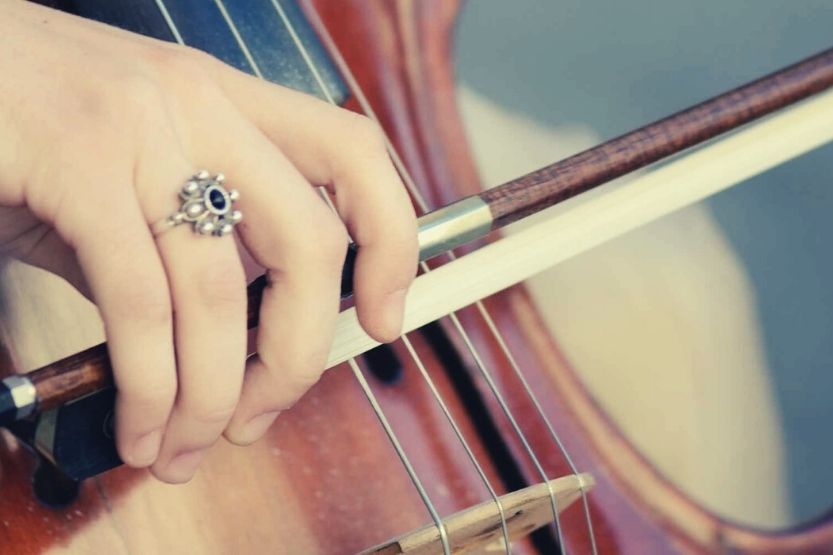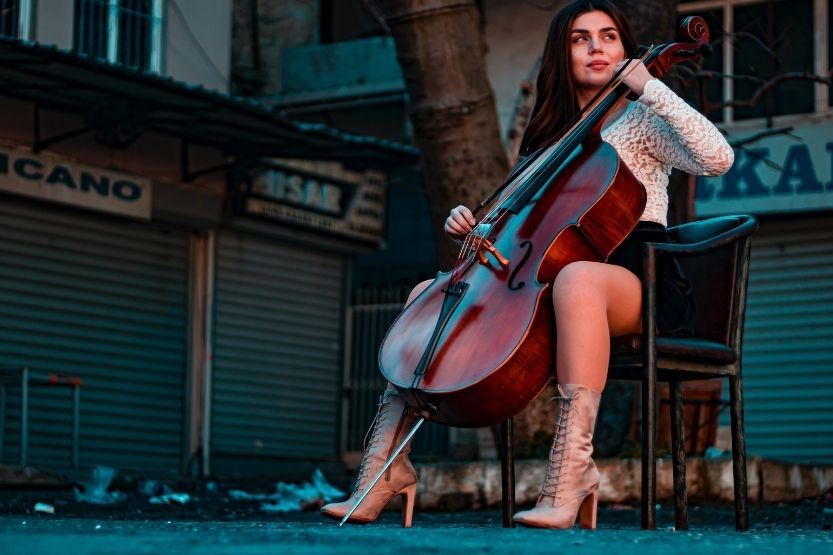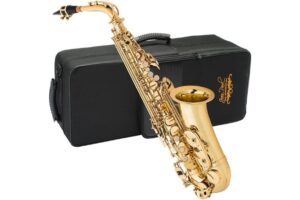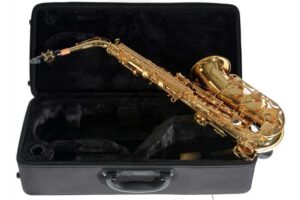Two of the most easily identifiable stringed instruments are the cello and the violin. The violin is the most famous. The cello is less well-known. What is the difference between a cello vs violin?
The violin is played propped up between the chin and shoulder. The cello is played sitting down and in between the knees, with the bottom pin on the floor for balance. The bow is held differently when playing violin and cello.
The table below shows the differences between cellos and violins:
| CELLO | VIOLIN | |
| Instrument Size (Full Size) | 47.6 inches (120.9cm) | 23 inches (58.4cm) |
| Weight | Over or about five pounds | 0.88 pounds |
| Material Used (Hardwood combinations) | Maple and Spruce | Ebony or Maple |
| String Gauge and Length | Thicker in diameter, longer in length. Less tension, lower frequency sound | Thinner in diameter, shorter in length. Higher tension, higher pitched sound |
| String Tuning | A, D, G, C | G, D, A, E |
| Bow | Tropical Hardwood + horsehair; Shorter length, wider gap | Tropical Hardwood + horsehair; longer length, narrower gap |
| Playing Position: | Typically seated | Either seating or standing |
| Compositional Requirements | Usually Tenor but more flexible in terms of range | Soprano |
| Mode of Transportation | May require special handling; can be difficult to bring in narrow or crowded areas | Portable and manageable in any kind of transport |
The most obvious difference between cello and violin is the size. Other differences include how musicians play them and the sound they produce when played.
Other, more particular differences of a violin vs. cello concern musicians more and require understanding how these instruments are constructed.
Read on to learn more about the differences between cellos and violins.
Also, we hope you find the links here useful. We may get a commission if you purchase something through a link on this page, so thank you!
Cello Vs Violin

The main differences between cello vs. violin are the size, how they are played, and their sound.
There are many other differences. Let us discuss each of these in the sections below.
1. Size Difference
Violins and cellos both come in varying sizes to accommodate a wide range of learners and professional musicians. Both instruments have their own full size, 7/8th size, 3/4th size, half size, and even smaller versions for young learners.
Note, though, that these fractional sizes are in no way a direct measurement of the instruments. These are mere representations of the approximate differences in sizing the stringed instruments.
Full-sized Violin
Click here to see this Eastar Violin 4/4 Full Size for Adults on Amazon.
A full-sized violin standing upright measures 23 inches (58.4cm) from its endpin to its scroll. Although this measurement also varies depending on the age and maker of the violin.
Full-sized Cello
Click here to see this Fantastic Finger Guide for Cellos on Amazon.
A full-sized cello measures 47.6 inches (120.9cm) from its base to its scroll.
To put it simply and literally, a cello measures twice the height of a regular violin. It may seem weird that the height differences are big, but we must remember that much of the cello’s height is there thanks to the endpin’s extended position.
Also, the cello is fuller in width and body structure, while the violin seems more fragile. The bodies of both instruments look similar, though, and work as chambers for reverberating sound.
2. Weight Difference
A standard-sized violin weighs about 0.88 pounds, about the weight of an iPad Air. On the other hand, a standard cello can weigh over or about five pounds, about the weight of a US-sized bag of flour.
3. Material Used
Usually, the material for both the cello and violin are a combination of hardwood types.
Factors That Affect the Type of Material Used
Generally, the materials used to make each instrument depend on several factors, such as the following:
- Style
- Age
- Origin country
- Luthier
A luthier is an expert craftsman who creates stringed instruments. One such famous luthier is Antonio Stradivari.
He and other luthiers use their expertise in complex woodwork techniques to construct an aesthetically pleasing and structurally sound instrument, has a strong and solid body, and most importantly, one that produces an exquisite sound.
Maple and Spruce
Most luthiers prefer a combination of maple and spruce in constructing a violin. The maple is for creating the neck, ribs, and scroll of the violin.
Ebony, Ivory, and Willow
Simultaneously, Luthiers use ebony to create more modern violins’ fingerboards, while older instruments have ivory fingerboards. Finally, the sounding chamber and face panel are made with spruce or willow wood.
Similar hardwood combinations are used for cellos, but ebony or maple are used mainly to construct the back and sides.
Laminated Wood or Composite Board
Cheaper wood materials such as laminated wood or composite board are used to produce mass-produced stringed instruments for a less expensive option. Note that the sound quality of mass-produced cellos or violins is largely affected by cheaper material.
4. String Gauge and Length
Needless to say, the strings of a cello are considerably longer than that of the violin. Cello strings are also thicker in diameter. Violin strings are considerably thinner and shorter and are strung under more tension causing a higher pitch.
Click here to see this Mendini By Cecilio Violin For Beginners on Amazon.
Not to say that cello strings are not under tension. It’s just that the strings are thicker and longer relative to the instrument. The thicker strings produce a lower frequency sound as compared to their thinner counterpart.
5. String Tuning Differences
Violin strings are tuned to G, D, A, E, while cello strings are tuned to A, D, G, C from the thickest string to the thinnest one. Note that the G string on a cello is a full octave lower than the violin’s G string.
6. Violin vs Cello – Bow

The bows used in violins and cellos are very similar. They are both usually constructed from tropical hardwood like the Pernambuco wood found in Brazil. Carbon fiber or composite may also be used.
Horsehair, preferably white, treated hair from a stallion, is used for the bow’s actual hair. But some musicians choose black horsehair for their bows as it has a coarser feel and better grip against the strings.
Bow Length
One major difference between cello and violin bows is the length. The cello bow is shorter than that of the violin and has a larger surface area of horsehair.
The rule here is, the bigger the string, the wider surface of horsehair it needs. Cello bows also have a larger gap between the wooden stick and horsehair for a sturdier disposition when playing.
Width
The violin bow has a more delicate bow, well suited for its size and sound requirement. It is thinner in girth but longer in length compared to a cello bow. And the gap between the wood stick and horsehair is smaller as well.
There may be differences in each bow’s making, but both are used similarly with either finesse or vigor to create the sound intended to be played by the musician.
7. Playing Position
As you might already know, the cello is played in a seating position, while the violin can be played with more flexibility.
Cello
The musician must straddle the instrument between their legs for a cello, with the strings facing outward. The neck and scroll will be positioned either to the left or right shoulder, depending on the musician’s dominant hand, while the body of the instrument will be rested on the player’s upper frame.
The cello’s bow must be played from the side and drawn across the strings at a horizontal angle. The playstyle is dependent on the musician’s individual preference.
You will rarely see a cello artist playing from the standing position as it is customary and more comfortable to play the instrument while sitting down. However, modern artists and street musicians may use the cello at a standing position for better showmanship or if the performance requires it.
Violin
The violin offers a more flexible playing style as it can be played while standing or sitting. The violin’s body will be rested on the player’s shoulder with the strings facing upward while it must be held in place using the chin or jaw bone.
Modern classical players equip a shoulder rest to provide a higher lift to the instrument, and a chin rest may also be included to keep the instrument secure.
The violin must be secured enough between the chin and shoulder that it would stay in place without holding it with your hands. This may prove weird and unnatural for beginners but gets relatively easier and more comfortable with time and practice.
8. Compositional Requirements
Like choral music, where singers are classified into sopranos, altos, tenors, and bass, stringed instruments also have a classification for their sound.
Violin vs viola vs cello? The violin is considered the soprano of stringed instruments, while the cello is the tenor. The viola takes the alto classification, while the double bass, as you might have already guessed, takes the bass part.
But if a cello will be used in a typical string quartet (where there are 2 violins, one viola, and one cello), it will most likely take the bass or alto role, thanks to its flexible range.
This change in compositional requirements is due to the demands brought about by polyphonic music. Luthiers construct instruments with the inherent requirements of the musical scale in mind.

9. Transportation
Portability in transportation may be an issue, considering the size and weight of a violin vs cello. A violin can easily be tucked inside a snug hard case and can be brought in practically any transportation type. It is a more manageable choice, even for a child.
Click here to see this Mendini By Cecilio Violin For Kids & Adults on Amazon.
Cellos, on the other hand, are bulkier and may require a safer way to transport. But with modern technology, modern-day cellos can now be transported much like how you would a large guitar – slung over the back.
However, it may prove difficult to navigate crowded public transport areas, tight spaces, or subway stations with stairs with a bulky cello.
Discover the scoop on Jenna Ortega’s Cello Skills: What We Know!
Conclusion – Violin Vs Cello
The difference between cello and violin is not a lot considering they come from the same kind, the stringed instrument. The main difference that even a non-musically inclined person can easily identify is, of course, the size.
Another would be how cello vs violin is typically played and how they sound like once played. You would have to try and learn each instrument to understand more of their similarities and differences.
As a recap, here is a rundown of all the features of a violin vs cello:
| CELLO | VIOLIN | |
| Instrument Size (Full Size) | 47.6 inches (120.9cm) | 23 inches (58.4cm) |
| Weight | Over or about five pounds | 0.88 pounds |
| Material Used (Hardwood combinations) | Maple and Spruce | Ebony or Maple |
| String Gauge and Length | Thicker in diameter, longer in length. Less tension, lower frequency sound | Thinner in diameter, shorter in length. Higher tension, higher pitched sound |
| String Tuning | A, D, G, C | G, D, A, E |
| Bow | Tropical Hardwood + horsehair; Shorter length, wider gap | Tropical Hardwood + horsehair; longer length, narrower gap |
| Playing Position: | Typically seated | Either seating or standing |
| Compositional Requirements | Usually Tenor but more flexible in terms of range | Soprano |
| Mode of Transportation | May require special handling; can be difficult to bring in narrow or crowded areas | Portable and manageable in any kind of transport |
Whichever is more convenient for you or more comfortable to play is a good choice to start with when it comes to experimenting with stringed instruments. Commitment and dedication are required to master any instrument but more so for a violin or cello.
These very classical instruments may seem intimidating at first, but these instruments will be a breeze to discover for a dedicated learner and a serious musician.
Their differences make each of these instruments unique, making them an essential part of an orchestra or a string quartet, or even a solo performance. To tell the differences in the sound they make is a step towards appreciating the beauty of these instruments.
Related reading:
Viola vs Violin: What Are the Differences?
Types of Violins [10 Different Violin Types]
Is the Violin the Hardest Instrument to Play?
Are There Left-Handed Cellos? Can You Play Cello Left-Handed?














